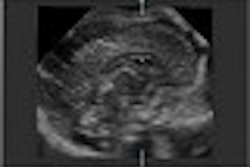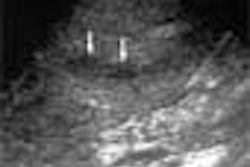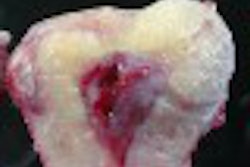(Ultrasound Review) The objective of a study by obstetricians at King’s College Hospital, London, was to scrutinize the feasibility and repeatability of three-dimensional ultrasound for measurement of nuchal translucency (NT).
"Forty consecutive women with uncomplicated singleton pregnancies attending for Down syndrome screening at 11-14 weeks’ gestation were included in this prospective crossover trial," the authors wrote in the December issue of Ultrasound in Obstetrics and Gynecology.
A number of pitfalls reduce the success rate for NT measurement. When the fetus is lying in an unfavorable position measurement of the NT is difficult. Sonographer experience and system-related image quality also influence measurement accuracy.
The authors investigated whether 3-D might overcome these limitations. "The main theoretical advantage of using 3-D ultrasound would be in cases when nuchal translucency measurement cannot be completed due to an unfavorable fetal position, they said." Rotating and re-slicing 3-D volumes enables the user to overcome this limitation, they added.
Two 3-D volumes were obtained. "The initial plane for the first volume contained a clear image of the nuchal region (sagittal), whilst the initial plane of the second volume was selected randomly regardless of fetal position. It was demonstrated that repeat NT measurements were possible in 95% of sagittal volumes and 60% of random volumes.
The resulting difference, between 2-D and 3-D NT measurements, were -0.097mm for sagittal volumes and 0.225mm for random volumes. They found that many (74%) of the 2-D midsagittal scans were in fact not the true midsagittal but the measurement error was insignificant. 2-D measurements took less time to perform, mainly because 3-D measurements can only be performed when there is no fetal movement.
They found that successful nuchal translucency measurement was possible using re-slicing of random volumes in only 60% of women. They emphasized that successful 3-D measurements were only possible using sagittal volumes when the initial plane included a good quality image of the nuchal region.
The authors concluded "re-slicing of stored 3-D volumes can be used to replicate nuchal translucency measurements only when nuchal skin can also be clearly seen on two-dimensional ultrasound." They asserted that because of this, the role of 3D for detecting Down syndrome at 11-14 weeks’ gestation was limited.
"Measurement of fetal nuchal translucency thickness by three-dimensional ultrasound"C Paul et al
Early Pregnancy and Gynaecology Assessment Unit, Dept of Obstetrics and Gynaecology, King’s College Hospital, London UK
Ultrasound Obstet Gynecol 2001 (December); 18:481-484
By Ultrasound Review
January 4, 2002
Copyright © 2002 AuntMinnie.com



















